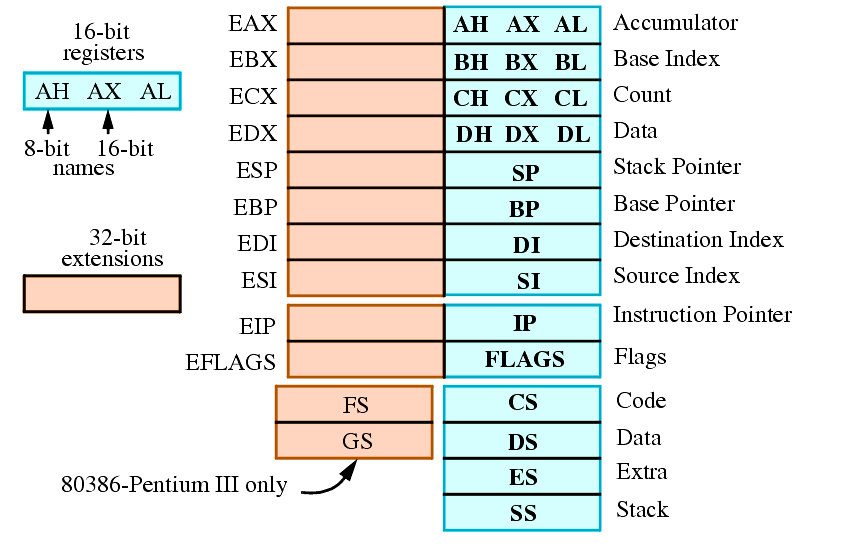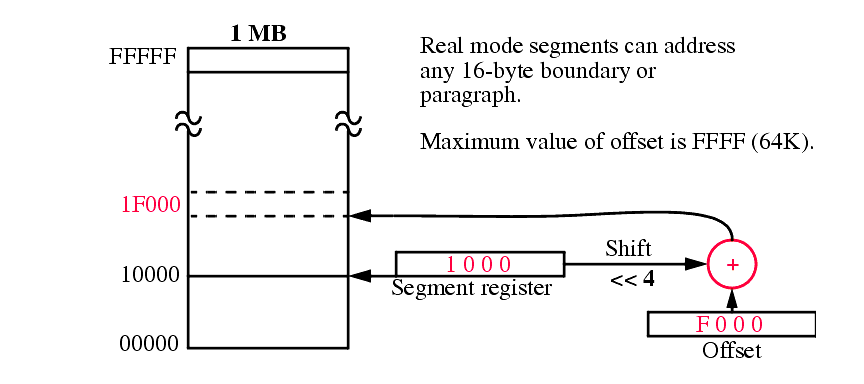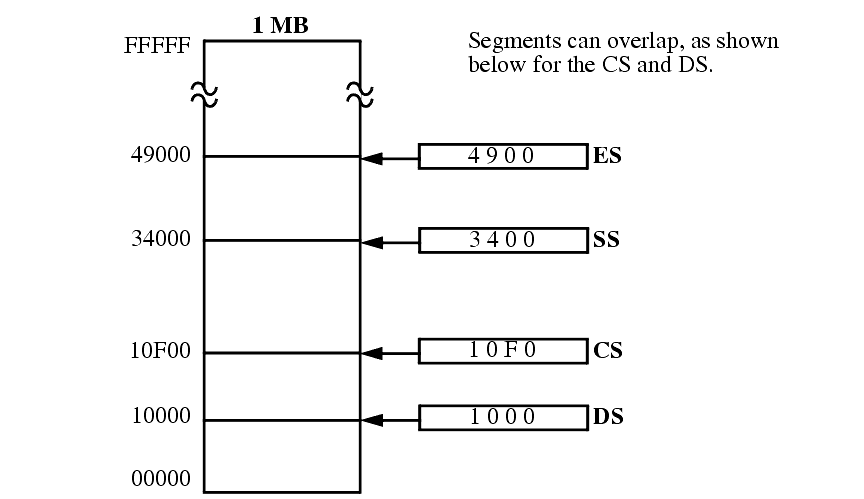n
Internal programmer visible architecture, e.g. registers
Real Mode Memory: 00000H-FFFFFH (the first 1MB of main memory).
n
Protected Mode Addressing: (covered later in the semester)
All of memory (applicable to 80286 and later processors).
Programmer invisible registers to control and operate the protected memory system.
n
80x86 Memory Paging. (covered later in the semester)
Programmer Visible Architecture
Programmer visible registers:
Programmer Visible Architecture
General Purpose Registers: The main functions are listed.
m
EAX: Accumulator: Referenced as EAX, AX, AL or AH.
Used to hold the offset of a data pointer.
Used to hold the count for some instructions, REP and LOOP.
Used to hold the offset of a data pointer.
Used to hold a portion of the result for mult, of the operand for div.
Used to hold the offset of a data pointer.
Holds the base pointer for memory data transfers.
m
EDI: Destination Index:
Holds the base destination pointer for string instructions.
Holds the base source pointer for string instructions.
Programmer Visible Architecture
Special Purpose Registers:
m
EIP: Instruction Pointer:
Points to the next instruction in a code segment.
16-bits (IP) in real mode and 32-bits in protected mode.
Used by the stack, call and return instructions.
Store the state of various conditions in the microprocessor.
Programmer Visible Architecture
Special Purpose Registers:
The rightmost 5 flag bits and overflow change after many of the arithmetic and logic instructions execute. Data transfer and control instructions never change the flags.
Holds the carry out after addition or the borrow after subtraction.
Also indicates error conditions.
0 for odd number of bits and 1 for even.
Obsolete feature of the 80x86.
Highly specialized flag used by DAA and DAS instructions after BCD addition or subtraction.
Programmer Visible Architecture
Special Purpose Registers:
1 if the result of an arithmetic or logic instruction is 0.
1 if the sign of the result of an arith. or logic instruction is negative.
Trap enable. The microprocessor interrupts the flow of instructions on conditions indicated by the debug and control registers.
Controls the operation of the INTR (Interrupt request) pin. If 1, interrupts are enabled. Set by STI and CLI instructions.
Selects with increment or decrement mode for the DI and/or SI registers during string instructions. If 1, registers are automatically decremented. Set by STD and CLD instructions.
Set for addition and subtraction instructions.
Programmer Visible Architecture
Special Purpose Registers:
n
IOPL (I/O privilege level):
It holds the privilege level at which your code must be running in order to execute any I/O-related instructions. 00 is the highest.
Set when one system task has invoked another through a CALL instruction in protected mode.
Used with debugging to selectively mask some exceptions.
When 0, the CPU can operate in Protected mode, Virtual 8086 mode or Real mode. When set, the CPU is converted to a high speed 8086. This bit has enormous impact.
Programmer Visible Architecture
Special Purpose Registers:
Specialized instruction for the 80486SX.
n
VIF (Virtual Interrupt Flag):
Copy of the interrupt flag bit.
n
VIP (Virtual Interrupt Pending):
Provides information about a virtual mode interrupt.
Supports the CPUID instruction, which provides version number and manufacturer information about the microprocessor.
Programmer Visible Architecture
In real mode, this specifies the start of a 64KB memory segment.
In protected mode, it selects a descriptor.
The code segment is limited to 64KB in the 8086-80286 and 4 GB in the 386 and above.
Similar to the CS except this segment holds data.
Data segment used by some string instructions to hold destination data.
Similar to the CS except this segment holds the stack.
ESP and EBP hold offsets into this segment.
m
FS and GS: 80386 and up.
Allows two additional memory segments to be defined.
Real Mode Memory Addressing
Only mode available to the 8086 and 8088.
Allow the processor to address only the first 1MB of memory.
Effective address = Segment address + an offset.
Real Mode Memory Addressing
Syntax is usually given as seg_addr:offset, e.g. 1000:F000 in the previous example to specify 1F000H.
Implicit combinations of segment registers and offsets are defined for memory references.
For example, the code segment (CS) is always used with the instruction pointer (IP for real mode or EIP for protected mode).
n
DS:EAX, DS:EBX, DS:ECX, DS:EDX, DS:EDI, DS:ESI, DS:8-bit_literal, DS:32-bit_literal
n
FS and GS have no default.
It is illegal to place an offset larger than FFFF into the 80386 32-bit registers operating in Real Mode.
Real Mode Memory Addressing
Segmented addressing allows relocation of data and code.
OS can assign the segment addresses at run time.



